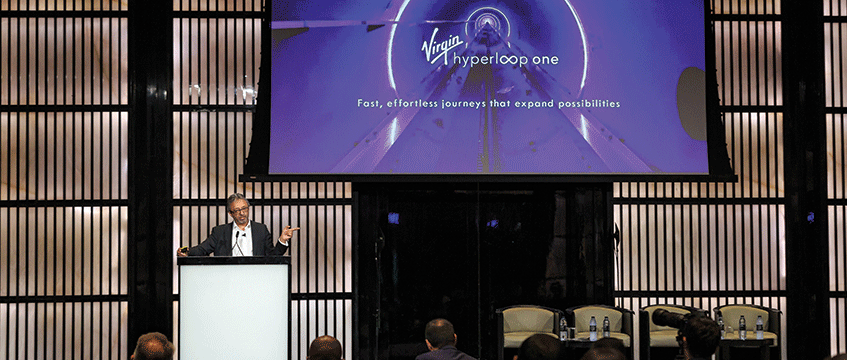The high-speed transport plan keeping you in the loop
“When we look back over the past 100 years or more, there hasn’t really been a fundamental new mode of transport introduced,” says Harj Dhaliwal.
“At Virgin Hyperloop One we’re now looking to introduce what we call the fifth mode of transport after planes, trains, automobiles and shipping.
“It will fundamentally change the way we view the travel of the future. More importantly, it’s breaking down that ultimate time and distance barrier. And when we eliminate that, then fundamentally everything changes.”
“When we look back over the past 100 years or more, there hasn’t really been a fundamental new mode of transport introduced,” says Harj Dhaliwal.
“At Virgin Hyperloop One we’re now looking to introduce what we call the fifth mode of transport after planes, trains, automobiles and shipping.
“It will fundamentally change the way we view the travel of the future. More importantly, it’s breaking down that ultimate time and distance barrier. And when we eliminate that, then fundamentally everything changes.”
It’s a grand claim by the managing director for Middle East and India Field Operations at Hyperloop One, but his is a business steeped in grand claims.
The idea of trains travelling through evacuated tubes has been discussed for decades. Elon Musk released a paper on how the technology might work in 2013.
Hyperloop One itself was born the following year and, to date, the likes of Virgin, DP World, Abu Dhabi Capital Group and French railway operator SNCF have backed the vision to the tune of almost $300m.
The technology would propel passengers – or cargo – through a low-pressure tube in pods that float above the track using magnetic levitation.
They would glide at airline speeds for long distances due to ultra-low aerodynamic drag. And at a cost comparable to high-speed rail delivery, there would be no carbon emissions.
“What we are doing right now is almost crossing over between space, aerospace and high-speed rail engineering,” says Dhaliwal.
“We are effectively travelling at the speed of flight but only a few inches off the ground.”
Each pod would carry cargo or up to about 28 passengers at a theoretical top speed of 1,080kmh.
Crucially, Dhaliwal says it could work anywhere but a likely launch region is already in mind.
“We are working predominantly in North America, the Middle East and India and we are also engaging in Europe. If I was a betting man, it would be Middle East and India.”
Could it first connect Abu Dhabi and Dubai, where Dhaliwal is selling EG’s Middle East Real Estate Forum his vision? “We’re actually very heavily engaged with the authorities here. It could well be,” he says.
But don’t think it is the wide open spaces of the desert that make it possible; Hyperloop could work in some of the most densely populated regions on Earth.
“One of the projects that we are looking at extensively right now is connecting the city of Mumbai with the city of Pune,” says Dhaliwal.
“Mumbai is 20m people and is probably one of the most dense and largest cities in the world. Pune is about 7m people and 140km away and is expected to grow twofold in the next 10 years.
What we are doing right now is almost crossing over between space, aerospace and high-speed rail engineering
“There is no space in Mumbai. When we get into that scenario we do go underground. It could have applications anywhere there is sufficient demand for it. And it doesn’t have to be travelling at 1,080kmh. It could be travelling at half that speed to give the economic benefits.
“If the demand is there, we can tailor the system so that it can run anywhere up to about 15,000 passengers per hour, per direction.”
Of course, it could also turn logistics on its head. Hyperloop-connected warehouses would increase their range and enable faster movement of goods over longer distances.
The upshot would be shrinking inventory lead times and the company estimates it could reduce the need for warehouse space and cost by 25%.
Here the savings could be even greater than the savings in transportation costs, especially for high-value, time-sensitive goods.
With Crossrail delayed and a degree of uncertainty surrounding HS2, it must be tempting for Wolverhampton-born Dhaliwal to say that the UK is pursuing 20th-century solutions to 21st-century problems.
He resists but he believes Hyperloop has a part to play in solving the UK’s transport infrastructure needs.
“The UK is a massive market,” he says. “It’s a fantastic opportunity for the UK to come on board right at the beginning and take advantage of a brand new ecosystem in high-tech, high-end manufacturing.
“I’m from the UK, I’d love to work in the UK. I would also say I’d expand it further.
“And when we start looking at applications of our technology, if you could link Stansted, Gatwick and Heathrow in the time that it takes for you to actually go from terminal to terminal, then would you really want to continue building up airports or would you want to use regional airports and connect them much better?”
With Hyperloop, Dhaliwal says, it is simply a question of where, not when.
“We’re working a lot in India. And India has got a track record of leapfrogging technology, as it did with the telecoms industry.
“I think you’ve got to start looking ahead because this is coming. Whether you believe it right now or not, it’s not far away. I would say that within the next eight years you will have operational Hyperloop systems around the world.”
To send feedback, e-mail damian.wild@egi.co.uk or tweet @DamianWild or @estatesgazette











